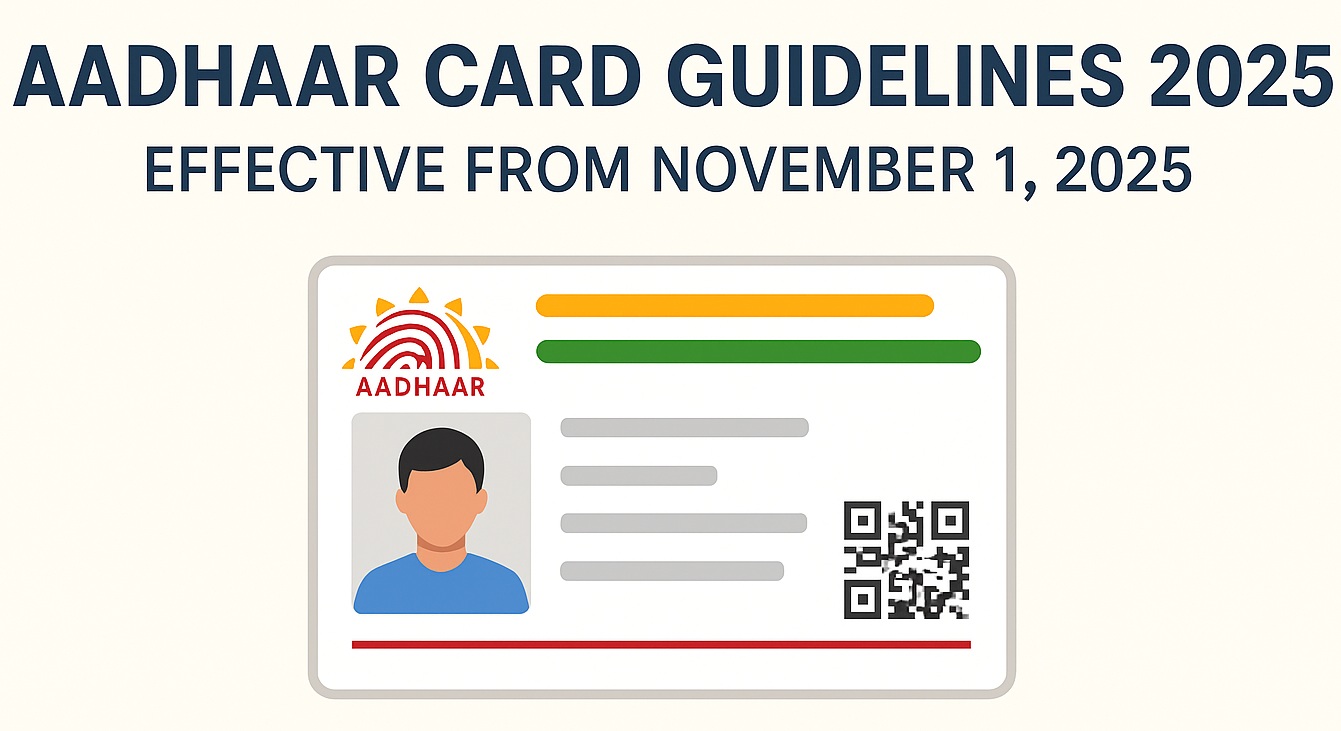Starting November 1, 2025, the Unique Identification Authority of India (UIDAI) will implement several key changes for Aadhaar cardholders across the country. The revised guidelines aim to make the process of updating Aadhaar details more convenient and secure.
Under the new system, residents can easily update crucial information—such as name, address, date of birth, and mobile number—online without visiting enrolment centres. The updates also include revised service fees and a reminder to complete Aadhaar-PAN linking by December 31, 2025, to prevent the deactivation of PAN.
UIDAI introduced these updates to make Aadhaar management easier and more accessible, helping people save time, avoid long queues, and keep their personal information accurate and up to date.
What is an Aadhar Card?
Aadhaar serves as more than just an identity document — it’s a key link to essential services such as banking, government subsidies, investments, and various welfare schemes. If you don’t update or correctly link your Aadhaar information (especially with your PAN), you may face disruptions in these services. As per recent reports, significant updates to Aadhaar rules will take effect from November 1, 2025.
Features of the Aadhar Card
1. Unique 12-Digit Number: Every Aadhaar card comes with a distinct 12-digit identification number issued by UIDAI, ensuring each individual has a unique identity with no duplication.
2. Comprehensive Personal Data: Aadhaar securely stores both biometric details—such as fingerprints, iris scans, and photographs—and demographic information like name, date of birth, gender, and address.
3. Accepted Nationwide: Recognized across India, Aadhaar acts as a universal proof of identity and address, valid for use in both government and private sectors.
4. Quick Digital Verification: Aadhaar supports instant online verification through OTP or biometric authentication, helping reduce identity fraud and enhance security.
5. Digital (e-Aadhaar) Option: Users can easily download a digital version of their Aadhaar from the UIDAI website, which holds the same validity as the physical card.
6. Seamless Service Linkage: You can conveniently link your Aadhaar to your PAN, bank accounts, mobile numbers, and welfare schemes to access services faster and avoid duplication.
7. Free Online Update Window: UIDAI occasionally provides a free online update facility, enabling users to correct or refresh their details without visiting enrolment centres.
Key Changes in Aadhar Card from 1st November 2025
From November 1, 2025, several important changes will take effect for Aadhaar cardholders. Here’s what you need to know:
- Online Demographic Updates: You can now update key personal details—such as name, address, date of birth, and mobile number—online without visiting an Aadhaar enrolment centre in most cases.
- Automatic Verification Through Government Databases: UIDAI will begin verifying your information automatically by cross-checking it with other government databases like PAN, passport, driving license, ration card, and birth certificate, simplifying the process and reducing manual document uploads.
- Revised Update Fees: UIDAI charges ₹75 for updating demographic details (name, address, date of birth, mobile number) and ₹125 for updating biometric details (fingerprint, iris, and photo) at authorized centers.
- Special Rules for Children: Biometric updates for children in the age groups of 5–7 years and 15–17 years will be either free or available at concessional rates.
- Mandatory PAN-Aadhaar Linking: All PAN holders must link their Aadhaar with PAN by December 31, 2025. Failing to do so will result in PAN deactivation from January 1, 2026.
- Impact on KYC and Financial Transactions: Banks and financial institutions will rely on active and verified Aadhaar numbers for e-KYC through OTP, biometric, or face authentication. If your Aadhaar is inactive, outdated, or duplicated, you may face delays or restrictions in financial transactions.
What action should you take?
To stay compliant and avoid any service disruptions, here are the key steps you should take:
- Verify Your Details: Visit the official UIDAI website or use the mAadhaar app to review your current Aadhaar information, including your name, address, date of birth, and mobile number.
- Update if Needed: If any of your details have changed—such as a new address or mobile number—update them promptly before the new rules are fully enforced.
- Link PAN with Aadhaar: Make sure your PAN is linked with Aadhaar before December 31, 2025, to prevent your PAN from becoming inactive.
- Update Child’s Biometrics: If your child falls within the biometric update age groups (around 7 or 15 years), ensure their Aadhaar information is updated accordingly.
- Keep Proof of Update: Always save your Update Request Number (URN) or acknowledgment receipt for reference and tracking.
- Prepare for Online Updates: When updating online, have your Aadhaar number, registered mobile, and relevant details handy.You may still need to visit the nearest enrolment centre for biometric changes.
- Maintain KYC Compliance: For bank accounts, investments, or other financial services, confirm that your Aadhaar details are current to keep your KYC status valid and avoid transaction issues.
What Happens If You Don’t Update Your Aadhaar?
If you fail to take timely action, you could face several issues:
- Outdated Information: Your Aadhaar may be marked as outdated, which can disrupt e-KYC verification and limit access to government benefits, banking services, or investment platforms.
- PAN Deactivation: If your PAN is not linked to Aadhaar by the deadline, it may become inactive, preventing you from carrying out key financial transactions.
- Additional Delays and Costs: Post-deadline updates may involve higher fees or longer processing times, causing unnecessary inconvenience.
- Children’s Aadhaar Issues: If parents skip biometric updates for their children, they could face complications later when using the child’s Aadhaar for verification or KYC purposes.
FAQs
Q1: How can I reactivate my deactivated Aadhaar?
Ans. If UIDAI deactivates your Aadhaar, visit the nearest Regional or State Office and submit a reactivation request with your biometric details. Once they verify your information, they will reactivate your Aadhaar number.
Q2: How can I find out whether my Aadhaar card is active or deactivated?
To verify your Aadhaar status, visit the official UIDAI website and navigate to the “Verify Aadhaar Number” section. Enter your 12-digit Aadhaar number along with the security code displayed on the screen.








